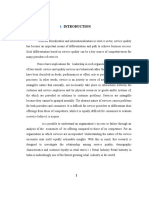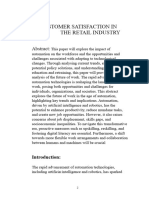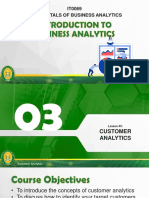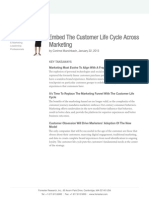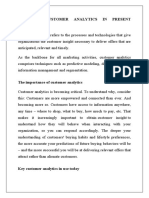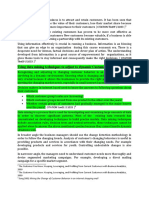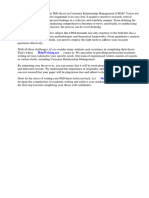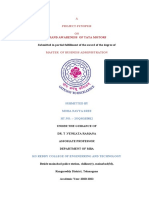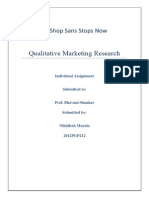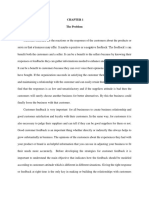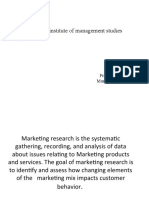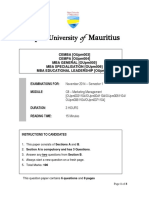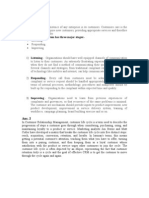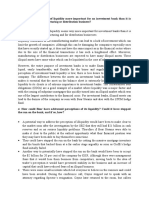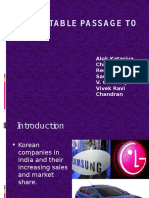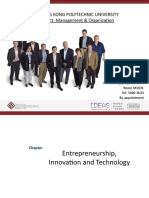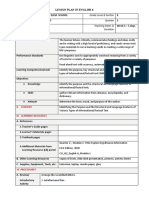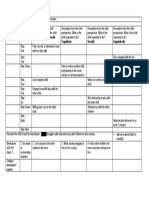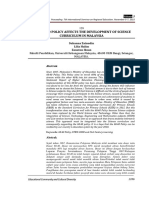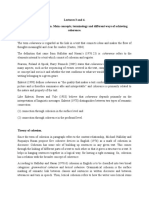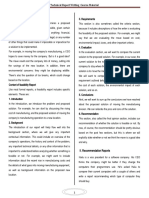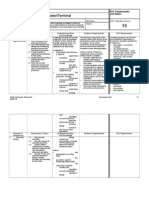Better Customer Insight - in Real Time
Better Customer Insight - in Real Time
Uploaded by
Saurav KumarCopyright:
Available Formats
Better Customer Insight - in Real Time
Better Customer Insight - in Real Time
Uploaded by
Saurav KumarOriginal Description:
Original Title
Copyright
Available Formats
Share this document
Did you find this document useful?
Is this content inappropriate?
Copyright:
Available Formats
Better Customer Insight - in Real Time
Better Customer Insight - in Real Time
Uploaded by
Saurav KumarCopyright:
Available Formats
Better Customer Insight
- in Real Time
ALOK KATARIYA
MS15A002
CHIRAG JAIN
REEMA JAIN
MS15A044
SAURAV KUMAR
MS15A050
V CHAITANYA
MS15A014
Traditional Marketing Tools
Quantitative methods
o
Quantitative researchis about asking people for their opinions in a structured way so that you
can produce hard facts and statistics to guide you.
E.g. Customer Satisfaction Survey
Qualitative methods
o
Qualitative marketing researchis amarketing researchmethod, which looking into the in-depth
motivations behind consumer buying behavior or opinions.
E.g. Focus Group and Interviews
Internet based
Ethnographic Research
o
Technique that allows companies to record complete range of customer experiences by
shadowing individual consumers and watch their behavior.
Disadvantages of Traditional tools
Quantitative and Qualitative :
o
Relies on Customers Memories which decay rapidly.
Consumers frequently recall company's communications inaccurately.
Biased by Context, eg: in case of a major purchase
Internet based :
o
Only for online interactions which is just 15% of customers encounters with companies and
their brands.
Ethnographic Research :
o
Labor Intensive and Expensive
Misleading as its hard to untangle individual quirks from general customer behavior.
Bias of an unconscious desire of pleasing the researcher, thus affecting ones reactions.
Real-time experience tracking
Developed by MESH Planning, a MR agency.
SMS based real time tracking using mobiles.
Supplies instant feedback from customers.
Relatively unbiased response.
Reduces surveys to just four questions.
Was born of two insights:
o
A market researcher cant follow a person 24 hours a day, but a cell
phone can.
You only need to know four things about each encounter.
Real Time Experience Design- 4
Phases
Challenges and Limitation of RET
Ensuring balanced representative sample.
Providing comprehensive list of touchpoints.
Tracking location of touchpoints through a text message is difficult.
Appropriate variation is necessary for varying sectors.
Assessing the effect of an individual consumers media consumption
without asking more questions is tough.
Problem of touchpoints where texting is limited. Eg: Airlines.
RET findings easier to implement in theory than practice; reaching,
mobilizing and coordinating all relevant decision makers is a huge
challenge.
How Data helps ?
Key Drivers
o
Applying simple regression to RET data can tell which touchpoints are most closely related
to individual customer behaviors.
E.g. Odds analysis
Competitive analysis
o
Comparing touchpoints of company and its competitors.
E.g. Touchpoint impact matrix
Chain of touchpoints
o
Customers reactions shaped by previous interaction with the brand.
Quality of purchasing experience will influence the likelihood that customer will buy or
recommend it or not.
Helps to know where the chains might be broken.
Conclusion:
Insights from RET can be acted upon immediately- great advantage in new
launches and campaigns.
RET enables companies to assess and respond in real time to customers
reactions to products, services, it can play a central role in allowing
customers to help design their own experiences with products.
As RET and tools like it emerge, we expect that marketing will cease to be a
game of stimulus- response and will evolve into a continual process of cocreation.
Thank You !!
You might also like
- OJT Performance EvaluationDocument5 pagesOJT Performance Evaluationgtan7294% (18)
- CRM at HondaDocument68 pagesCRM at Hondabhagathnagar71% (14)
- Self Therapy Workbook ExercisesDocument78 pagesSelf Therapy Workbook ExercisesEmilys Garde100% (9)
- PR 1 DiagnosticDocument5 pagesPR 1 DiagnosticLanieRasimoNo ratings yet
- Information System For ManagersDocument7 pagesInformation System For ManagersSakshiNo ratings yet
- Chapter 4 SummaryDocument3 pagesChapter 4 SummaryeudamnboredNo ratings yet
- Fim - Bear Stearns AssignmentDocument10 pagesFim - Bear Stearns AssignmentSaurav Kumar0% (1)
- The Effective HR ProfessionalDocument11 pagesThe Effective HR ProfessionalSarah FitchNo ratings yet
- Theory of Information ScienceDocument45 pagesTheory of Information ScienceriteshyuvarajNo ratings yet
- Crm in Action: Maximizing Value Through Market Segmentation, Product Differentiation & Customer RetentionFrom EverandCrm in Action: Maximizing Value Through Market Segmentation, Product Differentiation & Customer RetentionRating: 5 out of 5 stars5/5 (1)
- Customer Loyalty Thesis TopicsDocument4 pagesCustomer Loyalty Thesis Topicsmarthamaloneomaha100% (1)
- AbcdefgDocument6 pagesAbcdefgAkash BhambareNo ratings yet
- Customer Satisfaction and Loyalty ThesisDocument6 pagesCustomer Satisfaction and Loyalty Thesisanaespinalpaterson100% (2)
- UntitledDocument30 pagesUntitledchinni madhuNo ratings yet
- Dissertation On Customer BehaviourDocument6 pagesDissertation On Customer BehaviourBuyWritingPaperSingapore100% (1)
- Customer Service in IndustryDocument9 pagesCustomer Service in Industryanjaliyadav99738No ratings yet
- 003 Customer Analytics PDFDocument54 pages003 Customer Analytics PDFronjay julianNo ratings yet
- Embed The Customer Life Cycle Across Marketing - ForresterDocument15 pagesEmbed The Customer Life Cycle Across Marketing - ForresterAbbas KhanNo ratings yet
- 841345Document4 pages841345Mehar SheikhNo ratings yet
- Marketing AnalyticsDocument14 pagesMarketing AnalyticsayushNo ratings yet
- Dissertation On Customer RetentionDocument4 pagesDissertation On Customer RetentionWriteMyPaperApaFormatSingapore100% (1)
- Role of Customer Analytics in Present SituationDocument31 pagesRole of Customer Analytics in Present SituationmaryamNo ratings yet
- LOYALTY INSIGHTS 2 Creating A Reliable MetricDocument8 pagesLOYALTY INSIGHTS 2 Creating A Reliable MetricElvira007No ratings yet
- The Main Focus of Any Business Is To Attract and Retain CustomersDocument3 pagesThe Main Focus of Any Business Is To Attract and Retain CustomersMaryam NoorNo ratings yet
- PHD Thesis of Customer Relationship ManagementDocument4 pagesPHD Thesis of Customer Relationship Managementtjgyhvjef100% (2)
- Thesis Brand LoyaltyDocument7 pagesThesis Brand Loyaltyafknrbsaw100% (2)
- Qualitative Marketing Research: Its Shop Sans Stops NowDocument5 pagesQualitative Marketing Research: Its Shop Sans Stops Nowbinzidd007No ratings yet
- PHD Thesis On Brand LoyaltyDocument7 pagesPHD Thesis On Brand Loyaltysarahgordonanchorage100% (2)
- Relationship Marketing: The Dawn of New EraDocument39 pagesRelationship Marketing: The Dawn of New EraInder Singh100% (1)
- Mora Navya Sree - SynopsisDocument9 pagesMora Navya Sree - SynopsisKitten KittyNo ratings yet
- Murla Nikhilesh - QMR IADocument5 pagesMurla Nikhilesh - QMR IAbinzidd007No ratings yet
- ChethuDocument31 pagesChethuchinni madhuNo ratings yet
- Accenture Outlook: How To Make Your Company Think Like Customer - CRMDocument10 pagesAccenture Outlook: How To Make Your Company Think Like Customer - CRMPatrick CarverNo ratings yet
- Omnichannel The Perfect Storm Makes LandfallDocument34 pagesOmnichannel The Perfect Storm Makes Landfallpradeep0405100% (1)
- Customer FeedbackDocument9 pagesCustomer FeedbackAdmireNo ratings yet
- B.V.V Sangha's Institute of Management Studies Bagalkot: Presentation On Marketing ResearchDocument13 pagesB.V.V Sangha's Institute of Management Studies Bagalkot: Presentation On Marketing ResearchPrakash VadavadagiNo ratings yet
- How MKTG Is Leading Customer Experience, Global SurveyDocument12 pagesHow MKTG Is Leading Customer Experience, Global Surveyimranvdp306c2No ratings yet
- How Supply Chain Leaders Can Use Voice of The Customer To Improve Customer ExperienceDocument15 pagesHow Supply Chain Leaders Can Use Voice of The Customer To Improve Customer ExperienceDennis DuNo ratings yet
- A Study On Consumer Attitude Towards Online ShoppingDocument6 pagesA Study On Consumer Attitude Towards Online ShoppingAnu reethuNo ratings yet
- Types of Market ResearchDocument3 pagesTypes of Market ResearchBasit MirNo ratings yet
- MKTG 4240 Final Study GuideDocument14 pagesMKTG 4240 Final Study GuideTaylor 'BorensteinNo ratings yet
- Six Steps To Successful Monitoring of Your Customer ServiceDocument2 pagesSix Steps To Successful Monitoring of Your Customer Servicealeangulo89No ratings yet
- A Study On Dealers Perception Towars Johnson TilesDocument4 pagesA Study On Dealers Perception Towars Johnson TilesAmarNo ratings yet
- A Study On Consumer Survey Marketing in Three Axis Plate Pro Industry KarurDocument30 pagesA Study On Consumer Survey Marketing in Three Axis Plate Pro Industry KarurMeena SivasubramanianNo ratings yet
- Customer Satisfaction ThesisDocument6 pagesCustomer Satisfaction Thesisasiagroverprovo100% (2)
- Marketing FinalDocument7 pagesMarketing FinalMamta KarkiNo ratings yet
- "From Stretched To Strengthened - Insights From The Global Chief Marketing Officer Study." Executive SummaryDocument8 pages"From Stretched To Strengthened - Insights From The Global Chief Marketing Officer Study." Executive SummaryJustin SouterNo ratings yet
- Fuel Marketing Effectiveness With Customer AnalyticsDocument13 pagesFuel Marketing Effectiveness With Customer AnalyticsJohn ClarkNo ratings yet
- Three Steps To Brand Activation at Retail Executive Summary: You're in The SupermarketDocument14 pagesThree Steps To Brand Activation at Retail Executive Summary: You're in The SupermarketpaapuhomeNo ratings yet
- Naman Plag CheckDocument35 pagesNaman Plag Checkamity mbaNo ratings yet
- Business ResearchDocument7 pagesBusiness ResearchKunwer TaibaNo ratings yet
- Customers Rule! (Review and Analysis of Blackwell and Stephan's Book)From EverandCustomers Rule! (Review and Analysis of Blackwell and Stephan's Book)No ratings yet
- Myntrappt Original-1Document10 pagesMyntrappt Original-1Khushi GuptaNo ratings yet
- Customer Satisfaction Survey On AirtelDocument58 pagesCustomer Satisfaction Survey On Airtelsai thesisNo ratings yet
- Best Practices in Bank Customer Experience DesignDocument12 pagesBest Practices in Bank Customer Experience DesignEric Larse100% (1)
- Business Research MethodDocument12 pagesBusiness Research Methodhintsa weresNo ratings yet
- Application of Marketing ResearchDocument22 pagesApplication of Marketing ResearchVanisha SinghNo ratings yet
- UntitledDocument30 pagesUntitledchinni madhuNo ratings yet
- CRM (Pintu Vaishnav)Document12 pagesCRM (Pintu Vaishnav)pintuNo ratings yet
- Open Mauritius: UniversityDocument8 pagesOpen Mauritius: UniversitytagashiiNo ratings yet
- Quantitative Research To AbmDocument2 pagesQuantitative Research To AbmRic John Naquila CabilanNo ratings yet
- Individual Assignment - Customer Relationship ManagementDocument15 pagesIndividual Assignment - Customer Relationship ManagementBING JUN HONo ratings yet
- Assignment For CRMDocument8 pagesAssignment For CRMarti25sharmaNo ratings yet
- Allocation Rules For CRMDocument11 pagesAllocation Rules For CRMEkta VadgamaNo ratings yet
- Bear's Failure CaseDocument2 pagesBear's Failure CaseSaurav Kumar100% (1)
- Madhya Pradesh: 7. Development of Small, Medium and Large IndustriesDocument3 pagesMadhya Pradesh: 7. Development of Small, Medium and Large IndustriesSaurav KumarNo ratings yet
- A Profitable Passage To IndiaDocument7 pagesA Profitable Passage To IndiaSaurav KumarNo ratings yet
- How Economy Balancing Works?: Team Member: Alok Kataria Amlan Gourav Chirag Jain Morgane Bontemps Saurav Kumar UmasankarDocument4 pagesHow Economy Balancing Works?: Team Member: Alok Kataria Amlan Gourav Chirag Jain Morgane Bontemps Saurav Kumar UmasankarSaurav KumarNo ratings yet
- Coursera Assignment 3Document7 pagesCoursera Assignment 3Saurav KumarNo ratings yet
- M&O - 7 Entrepreneurship (Student)Document56 pagesM&O - 7 Entrepreneurship (Student)annaNo ratings yet
- Calculus ExamplesDocument4 pagesCalculus ExamplesnishagoyalNo ratings yet
- The Effectiveness of Online Education On Grade 11 Stem Students of Ama East Rizal S.Y. 2019-2020Document3 pagesThe Effectiveness of Online Education On Grade 11 Stem Students of Ama East Rizal S.Y. 2019-2020Alex WagnerNo ratings yet
- Bec Form 137Document2 pagesBec Form 137patrickkayeNo ratings yet
- BTCS604Document2 pagesBTCS604Parth ThakkarNo ratings yet
- Attitude Towards Learning Chemistry Among Secondary School Students in MalaysiaDocument12 pagesAttitude Towards Learning Chemistry Among Secondary School Students in MalaysiaasyiqqinNo ratings yet
- Research - A Way of Thinking: Chapter 1 - Research Methodology, Ranjit KumarDocument36 pagesResearch - A Way of Thinking: Chapter 1 - Research Methodology, Ranjit KumarAbhaydeep Kumar Jha100% (1)
- English6 - Q2 - DLP - Week 3 - Identifying The Purpose and The Structural and Language Features of Various Types of InformationalFactual TextDocument5 pagesEnglish6 - Q2 - DLP - Week 3 - Identifying The Purpose and The Structural and Language Features of Various Types of InformationalFactual TextLea Coronel100% (4)
- Coding and Technology For Teenagers LESSONS by ISRAEL Y.K LUBOGODocument7 pagesCoding and Technology For Teenagers LESSONS by ISRAEL Y.K LUBOGOlubogoNo ratings yet
- Psychodrama and Eating DisordersDocument134 pagesPsychodrama and Eating DisordersJoaodeCarvalho0% (1)
- Reading Comprehension Ability of Grade 6 Pupils in English and FilipinoDocument95 pagesReading Comprehension Ability of Grade 6 Pupils in English and FilipinoAnalyn Ismael100% (1)
- Task Analysis-Logan-Senior PortfolioDocument1 pageTask Analysis-Logan-Senior Portfolioapi-485797126No ratings yet
- The Mystical Dimension of ConsciousnessDocument21 pagesThe Mystical Dimension of ConsciousnessAbhijeet Kharat100% (1)
- 60:40 Policy PDFDocument10 pages60:40 Policy PDFSuhanna ZainudinNo ratings yet
- Theory of CohesionDocument8 pagesTheory of Cohesionarditadylgjeri_83235No ratings yet
- Kour 2019Document7 pagesKour 2019Karla Mae BolañosNo ratings yet
- Oumh 1103 Learning Skills For Open Distance LearnersDocument9 pagesOumh 1103 Learning Skills For Open Distance LearnersfmdeenNo ratings yet
- Note Feasibility Report FinalDocument3 pagesNote Feasibility Report Finaletsegenet lakewNo ratings yet
- Effect of Instructional Materials On The Teaching and Learning of Basic Science in Junior Secondary Schools in Cross River State, NigeriaDocument7 pagesEffect of Instructional Materials On The Teaching and Learning of Basic Science in Junior Secondary Schools in Cross River State, NigeriaFemyte KonseptzNo ratings yet
- DLL-Math 10 Quarter 2 Week 3 SY 2023-2024Document9 pagesDLL-Math 10 Quarter 2 Week 3 SY 2023-2024rhea diadula100% (1)
- Title: Balance Register/Terminal: Wrrf1BDocument5 pagesTitle: Balance Register/Terminal: Wrrf1BleakhanakNo ratings yet
- Unit 4 Assignment Brief Sem 2, 22-23Document6 pagesUnit 4 Assignment Brief Sem 2, 22-23yathursana24No ratings yet
- Strengths Finder Theme DescriptionsDocument6 pagesStrengths Finder Theme Descriptionstinkerman02No ratings yet
- Category Shifts in The English Translation of Harry Potter and The Philosopher's Stone Movie Subtitle Into Indonesia (An Applied Linguistics Study)Document8 pagesCategory Shifts in The English Translation of Harry Potter and The Philosopher's Stone Movie Subtitle Into Indonesia (An Applied Linguistics Study)International Organization of Scientific Research (IOSR)No ratings yet
- Compilation of The Topics in College Adjustments 1Document8 pagesCompilation of The Topics in College Adjustments 1orysanaldoNo ratings yet













